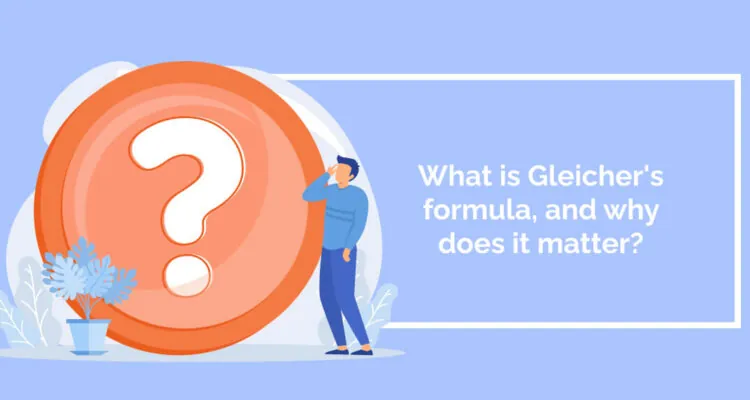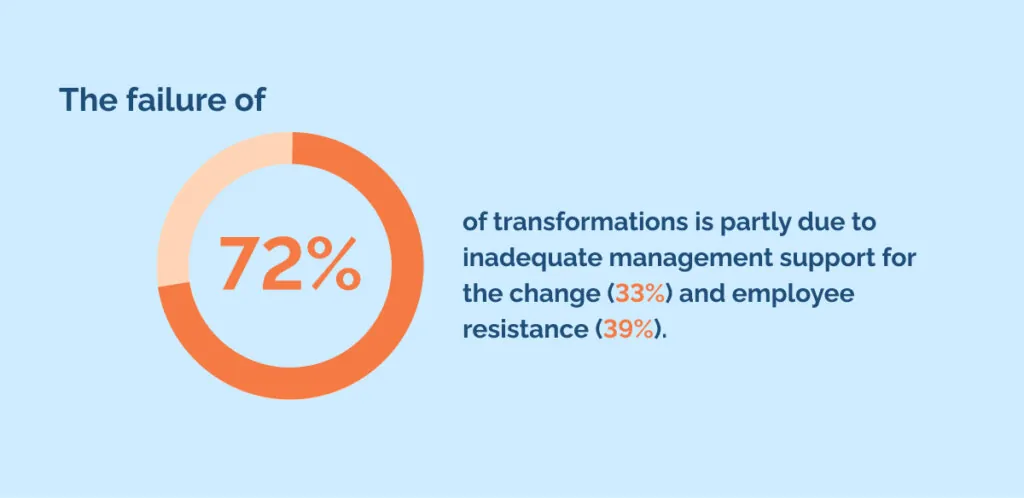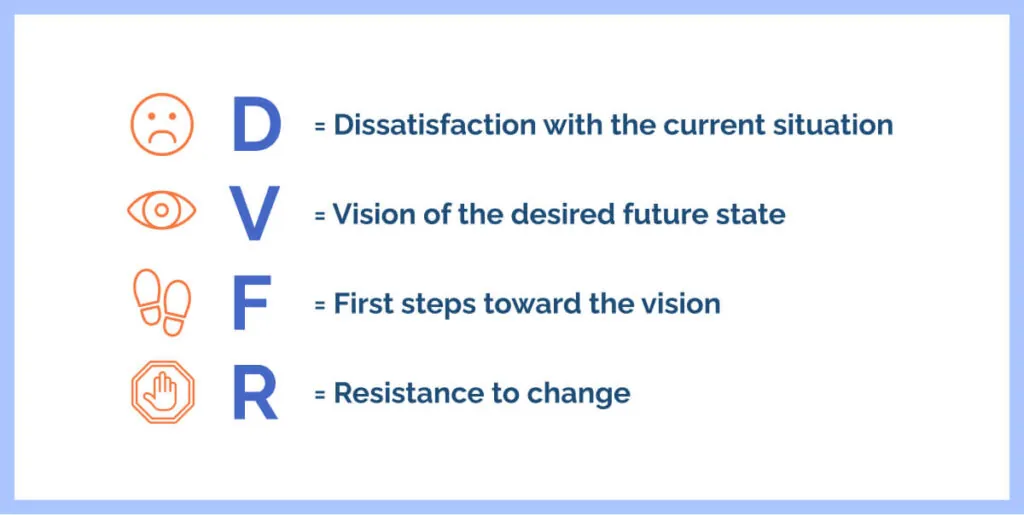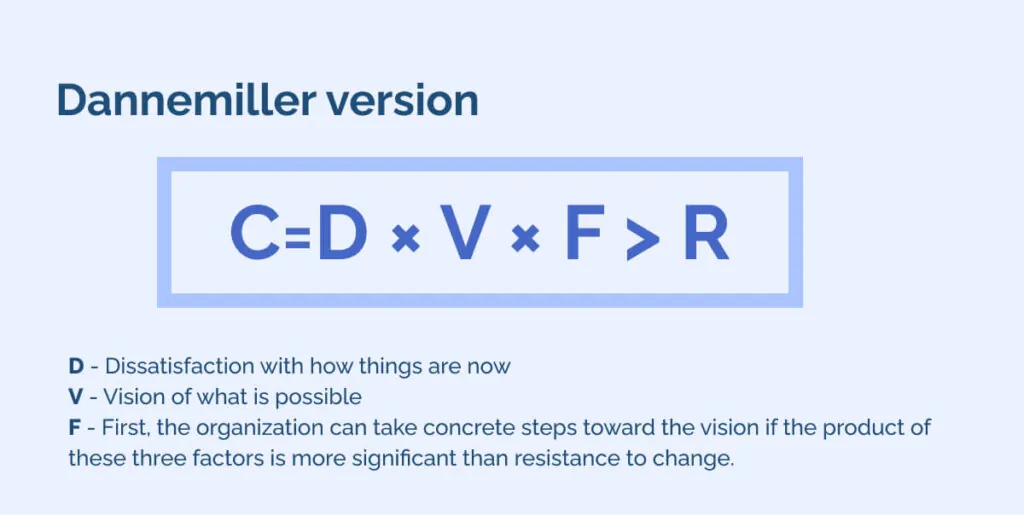
We hear a lot about many change management models, but many of the models that influenced later change theorists get left behind.
Gleicher’s formula for change, or the simple change model, was developed by David Gleicher in the sixties and helps organizations simplify the change process using an older but still effective method of achieving sustainable change without frustration or burnout.
Today, there is more pressure than ever to implement a successful digital transformation with a minimal negative impact on staff since we live in the digital age characterized by technology continuously pushing the boundaries of how quickly we can change processes, operations, and organizational culture with new technologies.
We only need to look to the explosion in interest in generative AI to see an example of the need for rapid change.
When one-third of change initiatives fail, it is essential to consider the best change management model to ensure success, and the Gleicher formula may be what you need to fulfill your needs.
This article will explore Gleicher’s formula, a simple yet powerful tool for change, covering its definition, significance, functionality, different versions, and practical use cases.
What is Gleicher’s formula, the simple formula for change?
Gleicher’s Formula suggests that change happens when Dissatisfaction multiplied by Vision and First Steps exceeds the Resistance to change. It is also known as the formula for change or the simple formula for change.
Simply put, the formula works by acknowledging several elements of the change process:
- Dissatisfaction leaders feel toward the current state of their organization.
- Their vision for the change they want to achieve.
- How practical they feel it will be to take initial steps to achieve the change.
- The resistance to change the organization faces.
Why does Gleicher’s formula matter?
Gleicher’s formula is not widely used and discussed in the business sphere, so it matters because using it may give you the edge you need to outcompete peer organizations.
Gleicher developed his formula for change in the earliest days of what we now call change management theory in the sixties.
Although this is after change pioneers like Lewin developed his three-stage change theory model, Gleicher was working ahead of his time compared to later famous change model crafters like Kotter, who created the eight-step process for change.

The failure of 72% of transformations is partly due to inadequate management support for the change (33%) and employee resistance (39%). Gleicher’s formula can help address these issues through methodical change management support practices.
It can be beneficial to look back to the origins of earlier change models to discover elements that may give organizations an edge today as leaders look to return to the original change management methods as efforts to manage change were in their infancy.
How does Gleicher’s formula work?
Many change management models can be challenging to understand, but Gleicher’s formula for managing change is simple.
The formula is: D x V x F > R
When we break it down, we can look at each part of the DVFR formula:

D = Dissatisfaction with the current situation
V = Vision of the desired future state
F = First steps toward the vision
R = Resistance to change
Gleicher’s Formula states that change requires Dissatisfaction, Vision, and First Steps multiplied together to surpass the Resistance to change.
In simpler terms, overcoming resistance involves having a high level of dissatisfaction with the current situation, a clear and appealing vision of the desired future state, and the perceived feasibility of taking initial steps toward that future state.
Let’s look at each step in more detail to discover how Gleicher’s formula works, beginning with Dissatisfaction.
D – Dissatisfaction
Dissatisfaction pertains to the discontent with the current situation. When people are content, the motivation for change may be low. Conversely, significant dissatisfaction can be a potent motivator for change.
V – Vision
Vision involves having a clear and compelling image of the desired future state. A strong vision can inspire individuals to work collectively towards a shared goal.
F – First Steps
The First Steps encompass the specific actions required to progress toward the vision. Staff must view these steps as feasible and achievable to prevent discouragement and increase resistance to change.
R – Resistance
Resistance involves factors that impede or obstruct change. It can stem from individuals or groups fearful of the unknown, concerned about potential losses, or skeptical about the success of the change.
Once Gleicher published his formula, others began to modify it to suit their aims and allow others to use it in different helpful ways. The versions of Gleicher’s formula are what we will cover next.
Versions of Gleicher’s formula
A few versions of Gleicher’s formula exist, which you can use to fulfill specific aims if the generic formula doesn’t achieve what you need in your change initiatives.
The main two variants of the formula belong to Dannemiller and Cady and focus on reconceptualizing the resistance to change element to ensure the formula is compelling from start to finish.
Dannemiller version

The first variation of Gleicher’s formula is the Dannemiller version.
Dannemiller reframed the formula with a focus on overcoming resistance to change:
C = D × V × F > R
This formula poses that three factors must be present for meaningful organizational change. These factors are:
D – Dissatisfaction with how things are now
V – Vision of what is possible
F – First, the organization can take concrete steps toward the vision if the product of these three factors is more significant than resistance to change.
For change to happen, you need D, V, and F. If any are low or missing, the overall result is zero or low, and you cannot overcome resistance.
Making change work involves using influence and strategic thinking. This point means creating an exciting vision and figuring out critical first steps.
Also, organizations need to listen to employees and share information about industry trends, leadership ideas, best practices, and competitor analysis. Doing so helps everyone see why change is necessary.
Cady version

The Cady version adds a fourth factor: S for Support for follow-through that also must be present for sustainable change to happen.
The Cady version of Gleicher’s formula is:
D × V × F × S > R
Again, the factors necessary to overcome resistance to change are:
D – Dissatisfaction with how things are now is often the same as Desire for change that requires a shared Database of information;
V – An ennobling Vision of where people come together in a pair.
F – First, concrete steps that leaders can take towards the vision.
S – Clear support for follow-through.
When multiplied, these four factors combine to overcome:
R – Resistance to change.
By focusing on supporting staff to overcome fears of change and other personal challenges they may face, the Cady version of Gleicher’s formula adds steps to ensure success, updating the formula into the digital age.
Use cases for Gleicher’s formula

There are many use cases for Gleicher’s formula, although, like all change management models, it is more useful in some use cases than others due to its strengths and limitations.
Firstly, the formula helps transform workforce behavior and skills.
1. Transforming workforce behavior and skills
Transforming workforce behavior and skills is a strategic endeavor. Applying Gleicher’s Formula emphasizes the need for a compelling vision, heightened dissatisfaction with the current state, and feasible initial steps. This step ensures a potent catalyst for successful workforce change in organizational dynamics and capabilities.
2. Overhauling processes, structures, and systems in an organization
Applying Gleicher’s Formula to overhaul processes, structures, and systems necessitates a clear vision, heightened dissatisfaction with the status quo, and feasible initial steps. This strategic approach ensures successful organizational transformation by addressing resistance and facilitating systematic change.
3. Transforming organizational culture
Transforming culture involves altering shared values, beliefs, and behaviors across an organization. These are perfect goals for organizations using the Gleicher formula as it helps take a broad view of an organization and how to build a healthy culture.
Use the Dissatisfaction (D) element of the formula to collect views from staff from all levels to ensure you build a complete image of what needs to change, and if you seek team member views on what should change about your culture, they are less likely to resist the change (R).
4. Adopting New Technology
Implementing new technology requires managing resistance, ensuring user adoption, and optimizing workflows, all of which Gleicher’s formula can facilitate.
Adapt this formula to provide a method to address employee concerns, facilitate training using a DAP, and integrate technology, enhancing overall effectiveness within the confines of the DVFR format to ensure success.
5. Modifying Products or Services
Adjusting products or services necessitates aligning teams, communicating changes effectively, and managing customer expectations. The Gleicher formula can offer structured approaches to ensure a smooth transition, minimize disruptions, and maximize stakeholder acceptance when organizations use it methodically and follow the DVFR format.
Combine Gleicher’s formula with other models for change success
To enhance change success, integrating Gleicher’s Formula with complementary models like Kotter’s 8-Step Model or ADKAR can be powerful as combining change management models can play to the strengths and weaknesses of each, and combinations can fit your organization’s goals.
Gleicher’s emphasis on vision, dissatisfaction, and feasible steps aligns seamlessly with these models, providing a comprehensive approach that addresses emotional and systematic aspects, fostering a more robust and sustainable transformation.
Combine Gleicher’s formula with the most suitable change models today to see transformative success, less burnout due to stress, and faster ROI as your business becomes more economically sustainable year-on-year.
Tristan Ovington
Tristan Ovington is a professional senior writer and journalist, specializing in providing expert insights on various topics such as digital adoption, digital transformation, change management, and Cloud apps. He delivers his knowledge through accessible online content that is data-driven and presented in a friendly tone, making it easy for readers to understand and implement.



